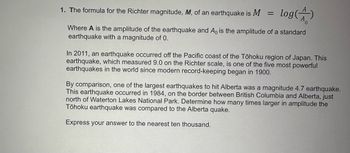
Calculus: Early Transcendentals
8th Edition
ISBN: 9781285741550
Author: James Stewart
Publisher: Cengage Learning
expand_more
expand_more
format_list_bulleted
Question

Transcribed Image Text:1. The formula for the Richter magnitude, M, of an earthquake is M
=
log(A)
Where A is the amplitude of the earthquake and A, is the amplitude of a standard
earthquake with a magnitude of 0.
In 2011, an earthquake occurred off the Pacific coast of the Tōhoku region of Japan. This
earthquake, which measured 9.0 on the Richter scale, is one of the five most powerful
earthquakes in the world since modern record-keeping began in 1900.
By comparison, one of the largest earthquakes to hit Alberta was a magnitude 4.7 earthquake.
This earthquake occurred in 1984, on the border between British Columbia and Alberta, just
north of Waterton Lakes National Park. Determine how many times larger in amplitude the
Tōhoku earthquake was compared to the Alberta quake.
Express your answer to the nearest ten thousand.
Expert Solution
This question has been solved!
Explore an expertly crafted, step-by-step solution for a thorough understanding of key concepts.
Step by stepSolved in 2 steps

Knowledge Booster
Similar questions
- 5. State the numeric value of the following -5 log, x log, (x-x) log,arrow_forward1. Evaluate the following. Final answer is in exact form, no decimals. 1 log, 16 – log, 32 log7 a) log, V165 log, 27 b) 343arrow_forward1. Chemical Acidity In chemistry, the acidity of a water-based solution is measured by the concentration of hydrogen ions in the solution (in moles per liter). The hydrogen-ion concentration is written [H*]. Because such concentrations usually involve negative powers of ten, negative orders of magnitude are used to compare acidity levels. The measure of acidity used is pH, the opposite of the common log of the hydrogen-ion concentration: pH = -log[H] More acidic solutions have higher hydrogen-ion concentrations. A certain brand of lemon juice has a pH of 2.1, and a certain brand of cleaning ammonia has a pH of 11.6. a) Find the hydrogen-ion concentrations for the lemon juice and the ammonia. b) How many times greater Is the hydrogen-ion concentration of the lemon juice than the ammonia?arrow_forward
arrow_back_ios
arrow_forward_ios
Recommended textbooks for you
 Calculus: Early TranscendentalsCalculusISBN:9781285741550Author:James StewartPublisher:Cengage Learning
Calculus: Early TranscendentalsCalculusISBN:9781285741550Author:James StewartPublisher:Cengage Learning Thomas' Calculus (14th Edition)CalculusISBN:9780134438986Author:Joel R. Hass, Christopher E. Heil, Maurice D. WeirPublisher:PEARSON
Thomas' Calculus (14th Edition)CalculusISBN:9780134438986Author:Joel R. Hass, Christopher E. Heil, Maurice D. WeirPublisher:PEARSON Calculus: Early Transcendentals (3rd Edition)CalculusISBN:9780134763644Author:William L. Briggs, Lyle Cochran, Bernard Gillett, Eric SchulzPublisher:PEARSON
Calculus: Early Transcendentals (3rd Edition)CalculusISBN:9780134763644Author:William L. Briggs, Lyle Cochran, Bernard Gillett, Eric SchulzPublisher:PEARSON Calculus: Early TranscendentalsCalculusISBN:9781319050740Author:Jon Rogawski, Colin Adams, Robert FranzosaPublisher:W. H. Freeman
Calculus: Early TranscendentalsCalculusISBN:9781319050740Author:Jon Rogawski, Colin Adams, Robert FranzosaPublisher:W. H. Freeman
 Calculus: Early Transcendental FunctionsCalculusISBN:9781337552516Author:Ron Larson, Bruce H. EdwardsPublisher:Cengage Learning
Calculus: Early Transcendental FunctionsCalculusISBN:9781337552516Author:Ron Larson, Bruce H. EdwardsPublisher:Cengage Learning

Calculus: Early Transcendentals
Calculus
ISBN:9781285741550
Author:James Stewart
Publisher:Cengage Learning

Thomas' Calculus (14th Edition)
Calculus
ISBN:9780134438986
Author:Joel R. Hass, Christopher E. Heil, Maurice D. Weir
Publisher:PEARSON

Calculus: Early Transcendentals (3rd Edition)
Calculus
ISBN:9780134763644
Author:William L. Briggs, Lyle Cochran, Bernard Gillett, Eric Schulz
Publisher:PEARSON

Calculus: Early Transcendentals
Calculus
ISBN:9781319050740
Author:Jon Rogawski, Colin Adams, Robert Franzosa
Publisher:W. H. Freeman


Calculus: Early Transcendental Functions
Calculus
ISBN:9781337552516
Author:Ron Larson, Bruce H. Edwards
Publisher:Cengage Learning